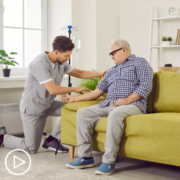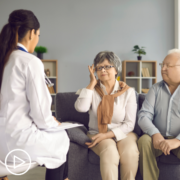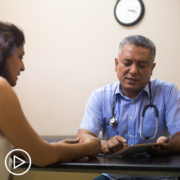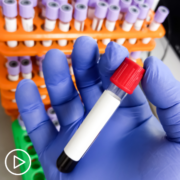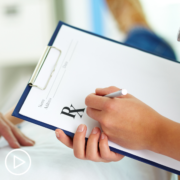How Is Bispecific Antibody Therapy Administered?
How Is Bispecific Antibody Therapy Administered? from Patient Empowerment Network on Vimeo.
How is myeloma bispecific antibody therapy given to patients? Nurse practitioner Alexandra Distaso from Dana-Farber Cancer Institute explains how the treatment is administered in the body, hospital types to access the treatment, and what patients should expect for the procedure and monitoring.
Alexandra Distaso, MSN, FNP-BC is on the Multiple Myeloma Nursing Team at Dana-Farber Cancer Institute.
See More from The Care Partner Toolkit: Bispecific Antibodies
Related Resources:

Bispecific Antibody Therapy | What is the Treatment Duration and Response? |

What Is the Role of a Care Partner in Bispecific Antibody Therapy? |
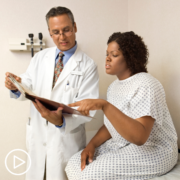
|
Transcript:
Katherine:
So, let’s dive into the process. How is this treatment administered, and what’s the frequency?
Alexandra:
So, currently, all of the bispecifics are given as subcutaneous injections.
And all of them do require a current hospitalization visit, somewhere between four and 10 days, depending on which medication you’re getting and what schedule you’ll be on. So, everyone is required to be in the hospital. Again, we’re trying to move that outpatient to minimize patients’ times in the hospital if we have to. And you get a lower dose with that first exposure to each of the medications, and then we build up the dose for the doses in the hospital into what will eventually be your outpatient weekly, or biweekly dosing.
Katherine:
Okay. Are there only certain medical centers that have this therapy? How widely available is it?
Alexandra:
So, right now, the step-up dosing, the inpatient hospitalization part of bispecifics is primarily only at academic medical centers. So, it is a little bit more restricted in that initial therapy. But what we are seeing is that a lot of the community practices are able to enroll and give these medications in the community.
So, some patients will come see us for a consult and the initial step up, but then they’re able to go back to their primary team after the first cycle so that they’re not commuting back and forth to Boston all the time.
Katherine:
That’s good to know. So, once the therapy has been given to a patient, what happens next?
Alexandra:
When you’re admitted for these initial step-up dosings, we closely monitor you for reactions in the hospital. That’s why we kind of are doing this in in-patient settings to monitor very closely for CRS and neurotoxicity, which we’ll talk about a little bit later. While you’re in the hospital, they’re checking your labs every day, they’re monitoring your vital signs, they’re doing silly questions like, “Do you know your name and the year,” to kind of monitor how you’re functioning. Once you have passed kind of the step-up dosing, either you’ll come back to me and your primary team at Dana-Farber, or we’ll communicate with your local team to set up your schedule for moving forward.

